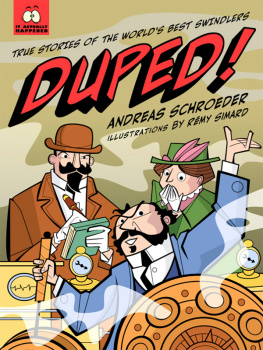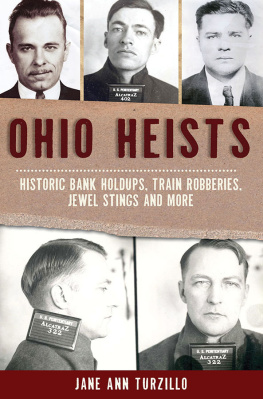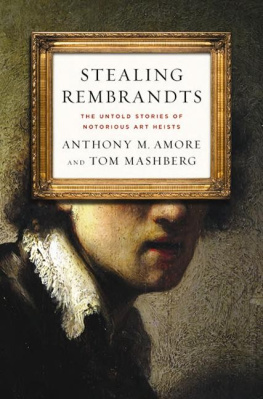
thieves!

true stories from the edge

Text 2005 Andreas Schroeder
Edited by Pam Robertson
Copy-edited by Elizabeth McLean
Cover design and interior design by Irvin Cheung/iCheung Design
Cover illustration by Scott Cameron
All rights reserved. No part of this work covered by the copyrights hereon may be reproduced or used in any form or by any meansgraphic, electronic, or mechanicalwithout the prior written permission of the publisher.
Distribution of this electronic edition without the permission of the publisher is illegal. Please do not participate in electronic piracy of copyrighted material; purchase only authorized electronic editions. Annick Press ebooks are distributed through Kobo, Sony, Barnes & Noble, and other major online retailers. We appreciate your support of our authors rights.
This edition published in 2012 by
Annick Press Ltd.
15 Patricia Avenue
Toronto, ON M2M 1H9
We acknowledge the support of the Canada Council for the Arts, the Ontario Arts Council, and the Government of Canada through the Canada Book Fund (CBF) for our publishing activities.

Cataloging in Publication Data
Schroeder, Andreas, 1946
Thieves! / written by Andreas Schroeder.
(True stories from the edge)
Includes bibliographical references and index.
ISBN 1-55037-933-X (bound).ISBN 1-55037-932-1 (pbk.)
1. RobberyJuvenile literature. 2. TheftJuvenile literature.
3. ThievesJuvenile literature. I. Title. II. Series.
HV6652.S36 2005 j364.15'52 C2005-901152-1
Visit us at www.annickpress.com
Contents
Look for more exciting titles in the award-winning series True Stories from the Edge:
Tunnels! by Diane Swanson
People have been tunneling since the Stone Age. These gripping stories of human drama beneath the ground are fast-paced and tension-filled.
Escapes! by Laura Scandiffio
History is full of daring escapes. The exhilarating stories in this collection take readers around the world and across the ages.
Scams! by Andreas Schroeder
Scam artists have been tricking people for a very long time. These dramatic stories explore some of the most outrageous and inventive swindlers of all time.
Fires! by Tanya Lloyd Kyi
Step into the blinding flames, the choking smoke, and the waves of heat that brought humans face-to-face with one of the worlds mightiest natural forces.
I would like to express my profound gratitude to my editor Pam Robertson, whose cheerful assistance proved invaluable too many times to count. Thanks also to Elizabeth McLean, for alert copy-editing that saved me more than once from certain embarrassment.
Introduction
Trying for the Big Score
OF ALL THE KINDS OF CRIMES that human beings have committed, stealing is probably the most common. Almost everyone has stolen something at some point in their lives. The impulse to simply take something we wanteven if it belongs to someone elsecan be irresistible.
It usually starts smalla boy palms a candy bar at a corner grocery store; a girl pockets a bottle of perfume at a drugstore. They get away with it once or twice, and then theyre caught. Usually the embarrassment and shame of being caught is enough to put a permanent stop to a budding thief.
But not always. Cassie Chadwick, who became one of North Americas most notorious female embezzlers, stole from an early age: jewelry, cosmetics, clothes, even groceries. She was often caught, but it never slowed her down. She stole so much and so often, a judge eventually pronounced her insane. He underestimated her. In 1902, she asked a group of Cleveland bankers to lend her huge sums of money based on her claim that she would be inheriting part of the estate of Americas richest industrialist, Andrew Carnegie. She proved this by taking the banks lawyers by carriage to Carnegies mansion in New York, and asking them to wait (she said Carnegie didnt like lawyers) while she met with Carnegie.
She was inside for nearly half an hour. When she came out, she triumphantly showed them two checks for almost a million dollars, made out to Cassie Chadwick and signed by Carnegie.
The lawyers were impressed, and Cassie got her loanswhich, of course, she never repaid. To pull off this scam, she had simply knocked on the door, told the maid she was feeling faint, and asked for permission to lie down on a bench in the foyer for a few moments. The kind-hearted maid had agreed. After half an hour, Cassie had felt better and left the house. The lawyers had assumed shed been spending all this time with Andrew Carnegiewho, it turned out, hadnt even been home.
STEALING, OF COURSE, becomes easier if your victims seem to beg you to do itby leaving their front door unlocked, or their keys dangling in the ignition. That, in effect, was what the French government did in the 1960s, when it decided to pay its citizens to have more babies, to offset that countrys alarmingly low birthrate. It offered French families annual payments of $1,100 each for their first two kids, $1,500 for their third, and $1,850 for every fourth and additional child.
This offer quickly attracted the attention of a Romany gypsy named Jimenez Moreno. Moreno already had a family of 12, so he stood to benefit rather handsomely from the governments plan. But he soon realized there was even greater booty to be had. Since the plan didnt require a fixed address, he loaded his family into a big camper van, hit the road, and, using a variety of names, registered his family for the baby bonus in every town through which he passed. He did this without let-up for five whole years. By the time the government realized what was going on, Morenos family had been registered in 354 towns, and he had stolen almost $15 million from the plan. And the French government never retrieved a penny of that money. Someone warned Moreno that the police had discovered his deception, and he quickly disappeared over the border into Spain. He was never caught.
Thieves like Moreno, however, are the exception. Most thieves are eventually caughteven the really successful ones. And when theyre caught, they generally find themselves in a serious fix. Thats because most thieves steal in hopes that theyll make the big score one day, the theft that will allow them to retire to some South Seas island with truckloads of money. But thieves are also notorious spendthrifts. When they make a big score, they party. They feel a great need to show off their successand blowing their ill-gotten gains on extravagant parties is one way to do this. Another is to buy huge mansions, flashy cars, or luxury yachts. The problem is that to spend a lot of money, youve got to keep stealing a lot of money. So a thiefs life can become a treadmilland when the police finally come knocking, that treadmill crashes. Any money left is usually taken by the lawyers and the courts, and if the thief is sentenced to jail time, his possessions on the outside are often stolen by former partners or friends.
Many professional thieves end their careers broke and disillusioned.
SOAPY SMITH IS A GOOD EXAMPLE. At the height of his thieving career, in the 1890s, Soapy Smith practically owned the town of Skagway, Alaska, which was the doorway to the Alaska gold rush. After years of thieving solo in the American Midwest, Soapy had gone north and become so successful that he now had a whole army of thieves working for him. They were a well-organized crew. Every boat that arrived in Skagway was met by a town official who informed all the passengers that a decent haircut was a legal sanitary requirement in Skagway. As the passengers sat in their barber chairs, the barbers (who were also on Soapys payroll) grilled them for information, determining who had money, who was an easy victim, and who was too well-connected or too politically powerful to rob. Anyone deemed a good candidate had a faint V cut into the hair at the back of his head. Such easily recognized people were invariably robbed the same day by Soapy or one of his roving thieves.
Next page




















